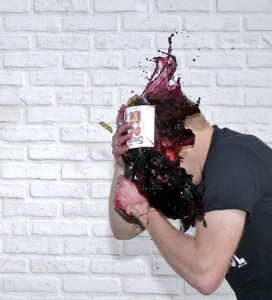Berkeley is a great place to get drunk. Nowhere else in the world will you find yourself at a Santa Maria BBQ surrounded with former Black Sabbath roadies, Argentinian media darlings and industrial architects discussing the I Ching at candlelight with the most lovely $5 wine. Sorry Virginia, that country club swill you call cabernet just won’t measure up, and maybe you can find the I Ching somewhere in Greenwich Village, but how many of those conversations would end with mystical guidance to unemployment? Berkeley is the place people go to be unemployed…and chemically enlightened. And honestly it makes for the most delightful and entertaining dinner parties.
Unfortunately, Berkeley is also a terrible place to be hung over. The weather is painfully sunny, every day; not a single cloud in the sky. And people are always cheery, because it’s sunny, every day. Which you would think would be fun, until you’re hung over and it is not fun. It is not fun at all.
An overabundance of the best quality wine at “low, low prices” makes every dinner party an unsobering event. It’s not uncommon to meet people on the street who are so pickled they no longer need to drink. Their skin is made of Cabernet, their eyes flooded by Pinot Grigio, they get pulled over while sober because their lifestyle has made them impaired. But this is the conflicted relationship Californians have with wine: delightful as it slowly turns your skin a deep shade of purple, making your blood tannic and your lifestyle delusional.
When I first started on this blog, I wrote a piece about climate change making Napa valley and associated snooty locales an ideal place for wine-grape growing, as a shift in climate also correlated with the boom in the fancy wine industry. And who am I to deny that the wine is top notch here? It just is.
This finding was the lighter side of more controversial research that has been bouncing around for quite some time, which suggests that with a changing climate, some areas known for their charming varieties will become less hospitable to grapes. In fact a recent analysis found that current major wine producing areas globally are going to become less suitable, forcing grape farmers to either use more water or move their vineyards to cooler upslope areas, thereby potentially encroaching into new areas (1). A wine tragedy turns into a conservation disaster.
But, no wine-lover would take such news sitting down, and of course, they didn’t. The response was swift! Yes, yes of course if vineyards expand into new areas this could have negative ecosystem impacts and sure water use is totally a big deal, but how dare you even suggest that the wine-producing areas worldwide will dramatically decrease by 2050 (2). Bite. Your. Tongue. Heathen.
The real issue came down to how to best plot out a model for global shifts in grape production—which parameters to use, how to make comparisons and connections, and whether a crop known and loved for its regional cultivation (the fresh coastal notes vs. the bold inland flavors) can be used as a model crop for this question: how will global shifts in agricultural management due to to climate change impact conservation? And if you can answer said question, can you do it without infuriating the global wine market?

The original authors fought back at the wine enthusiasts (3). “You fools!” They said (in science lingo that sounds far more intelligent), “We don’t care about wine, we care about conservation! The vineyards will no doubt stay where they are regionally, they will just require more water and potentially encroach into new areas. That is what we care about: conservation! Not your pesky Merlots!”
To which the wine enthusiasts no doubt scoffed is disgust, “ugh, Merlot? Really? You don’t know us at all.”
And therein lies the controversy, though the argument appears to be based in the best way to model climate change impacts on agriculture, the undertone is one of concerns for a pricey commodity vs. conservation. Which should we be more worried about?
That sounds like a great question for my next dinner party. While we are at it we can address all the drink controversies: wine and conservation, diet soda and obesity, the oppression of kombucha mothers…this is Berkeley after all. We take our drinking seriously.
Further Reading:
(1) Climate change, wine, and conservation
(2) Why climate change will not dramatically decrease viticultural suitability in main wine-producing areas by 2050
(3) Reply to van Leeuwen et al.: Planning for agricultural adaptation to climate change and its consequences for conservation
